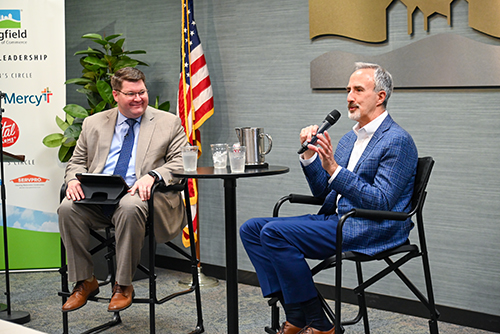Public Policy Speaker Series with Dr. Bennett Boggs

Missouri Higher Education and Workforce Development Commissioner highlights workforce and education opportunities, challenges at Public Policy Speaker Series
On October 11, Dr. Bennett Boggs, Commissioner of the Missouri Department of Higher Education and Workforce Development, engaged with Chamber members during the second edition of the 2024 Public Policy Speaker Series. Boggs described his department’s strategic focus, his extensive experience in higher education, and current trends, challenges and plans within workforce development and postsecondary education for the coming year.
“Missouri has an opportunity to set the mark for how to invest in workforce preparation,” said Boggs, emphasizing the state’s unique position to lead the nation in this area.
Boggs assumed his role as Commissioner in April 2023 from where he leads the department’s work to ensure every Missourian is empowered with the skills and education needed for success. He came to the role with a strong background in several higher education roles and noted the significance of Missouri being the only state with a department designed to intentionally merge higher education and workforce development. This combined mission was established in 2019 to help realign postsecondary education with the public workforce system, giving individuals the full breadth of options available to fit their interests, resources and abilities.
“I think it is an opportunity, as I don't think it's an accident that other states are calling and asking how we do things in Missouri,” said Boggs.
A key priority for Boggs is to improve access to workforce development opportunities by addressing barriers to building a skilled and qualified workforce. He shared that 72% of jobs in the nation require some level of education or qualification past a high school diploma, which is expected to increase to 82% of new jobs by 2035. He believes an essential step to helping Missouri overcome this barrier is creating an environment where institutions can form beneficial partnerships with the business community to identify needed skills and ultimately develop a robust and qualified workforce.
A challenge for higher education, notes Boggs, is that it is always changing. Boggs identified demographic changes affecting higher education, such as a decrease in the number of traditional high school-age students entering college institutions, as a cause of community uncertainty. However, the number of adult, non-traditional students in higher education has increased, presenting a unique opportunity to invest in this population.
Boggs posits that post-secondary institutions should focus on partnerships to bring these non-traditional students back to colleges and universities to pursue or finish degrees, and ultimately get the skills they, and employers, need.
“What I am encouraging us to consider is that our institutions can be a community asset to help address uncertainty and provide reassurance in the community,” said Boggs. “They know how to help the community cope with changes in workforce pipeline, credentialing, technological and economic changes.”
As the department looks ahead to execute the strategic plan for higher education, Boggs aims to reach statewide goals for both workforce and higher education. That current goal is achieving a 60% attainment rate across Missouri for some form of post-secondary education and a 70% goal for full employment in well-paying jobs. According to Boggs, Missouri currently stands at roughly 51% for the post-secondary attainment goal and roughly 63% for the workforce goal.
Thank you to your Presenting Sponsor Hahn | DeBoef Government Relations and Seasonal Gold Sponsor CoxHealth!

